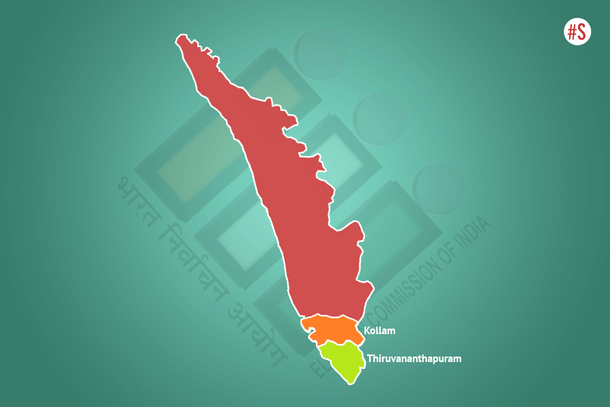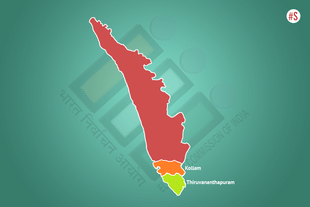Politics
Kerala Assembly Elections 2021: How Kollam And Thiruvananthapuram Will See New Trends But Mostly Old Results
Venu Gopal Narayanan
Mar 26, 2021, 02:23 PM | Updated 02:23 PM IST
Save & read from anywhere!
Bookmark stories for easy access on any device or the Swarajya app.


Read first, second and third parts of this series.
In the fourth part of our series on the electoral fortunes of 140 assembly seats in Kerala, we review the situation in the two final districts of Kollam and Thiruvananthapuram. The data used is from a pre-poll survey conducted by Manorama-VMR last week.
As we have seen in our slow trek south, the axe-born of Parashurama’s land appeared set to give Chief Minister Pinarayi Vijayan and his Left Democratic Front (LDF) a second term. But with 25 seats to go, an upset by the Congress-led United Democratic Front (UDF) was still technically on the cards, because the last mile is always the hardest.
In 2016, the LDF swept Kollam district, winning all 11 seats. It was a stunning, decisive victory which took the wind out of the Congress sails. This time round, the survey predicts that the UDF will claw back in four seats, leaving the communists with ‘only’ seven.
However, there are issues with these predictions. The principal constraint is an apparent underestimation of the BJP’s tremendous surge in Kollam, propelled in part by the contribution of its Ezhava Other Backward Class ally, the Bharat Dharma Jana Sena (BDJS).
This is important, because the BJP and BDJS candidates, under a National Democratic Alliance (NDA) banner, appear to be attracting Nair votes from the UDF, Ezhava votes from the Left, and a small portion of Christian votes from both the UDF and the LDF; to the extent that the BJP is set to push the Congress to a distant third place in at least two Kollam constituencies — Chadayamangalam and Chathanur.
In fact, Kollam is the first district where we see the stirrings of a new electoral trend in Kerala — of the Congress getting squeezed out by the BJP and the Left. We got a first glimpse of it in the 2020 December local body polls, when for the first time the BJP won multiple wards with clear majorities; and we can expect to see that novel trend manifest itself more prominently in the forthcoming assembly elections.
The impact of such developments is most telling in Eravipuram seat (to be contested by the BDJS). For the past few decades, both the UDF and the LDF usually used to put up Muslim candidates, to try and take advantage of the fairly significant Muslim population in this seat. But this time, the NDA’s vote share here was already pegged at over 27 per cent, even before candidates were selected.
Sensing this mood swing, and feeling the painful pinch of the Christian Kerala Congress who left them for the communists, the UDF has quietly junked its vaunted secularism and gone with a Hindu candidate in Eravipuram. That is a humiliating come down for a Congress coalition, which had hitherto fashioned so many electoral victories on the plaintive bleats of minority victimhood, and a manufactured fear of evil, fascist Hindu majoritarianism.
Nonetheless, the net effect of the NDA’s sharp rise, allied with the shift of votes from both the UDF and the LDF to the NDA, is that it makes contests much tighter than projected. In numerical terms, it makes the Congress more dependent on the Muslim vote, in an area where that community is not decisively populous, and thereby less capable of turning the tide. Add to that the impact of the Kerala Congress’s departure, and it is quite possible that the UDF may score less than the four gains projected presently for them in Kollam. It is equally possible that the BJP could spring a surprise in one seat.
But all of that pales when we reach Thiruvananthapuram. In 2021, the big story is that the Congress and the UDF look set to get comprehensively wiped out of this district. Of the 14 seats on offer, the Left is projected to win 12 (up two from 2016), the BJP may win two (up one), and the Congress will be reduced to introducing shunyata into their electoral conversation.
This is huge, and has major political ramifications. Readers may also note that these survey numbers were collected before the BJP finalised its candidates list, and before any serious campaigning had gotten underway. Thus, as on date, it is predicted that the BJP and the BDJS will do better than the surveys predict, more to the detriment of the UDF, than the Left.
In Thiruvananthapuram city seat, which the BJP is projected to win, their candidate is popular actor Krishna Kumar. His party came in a very close third in 2016, which the Congress finally won. This time, it is the Congress which is being pushed to a distant third place, with a vital 5-6 per cent Tamil AIADMK votes, who always voted for Amma’s party, now expected to shift in bulk to the BJP by virtue of being an NDA ally.
In Kazhakootam, the contest is between the BJP’s Shobha Surendran (an Ezhava, and a veritable firebrand) and the Left’s Devaswom Minister, K Surendran. Sabarimala will be an issue here, the minister is the public face of a government which people view as having defiled sacred traditions, and the BJP could win. The Left thinks so too, because of which, Minister Surendran recently tried to effect some damage control by apologising for that defilement. His contrition was not too well received.
So too in nearby Kattakada seat, where a widespread saffron groundswell is steadily pushing the Congress out of all contention, while drawing significant votes from the Left. The state capital region is, in fact, one of the few places where Sabarimala distinctly manifests itself as an important electoral issue.
What remains to be seen is whether the Left’s contrition, their pandering to the local Nadar OBC community in the Thiruvananthapuram area (through changes in reservation policies), and the Christian vote, will aid them in stemming the BJP’s rising tide. One indicator is Aruvikkara seat, which the LDF is projected to gain from the Congress, via a shift of Nadar and Christian votes.
For the Congress, their sole shot at redemption is in Nemom seat — presently held by the BJP’s O Rajagopal. Their candidate is big hitter K Muraleedharan — son of former Congress chief minister K Karunakaran, and one of the last few Nair faces left in the party. In 2016, Muraleedharan defeated the BJP’s Kummanam Rajashekaran by 7,622 votes in an adjoining seat. This time, both men face off again in Nemom, along with the Left’s V Sivankutty who won here in 2011.
To aid their candidate, the Congress spin doctors have floated a new one locally — that the BJP vote in Nemom is actually a Rajagopal vote; and that with him retiring from active politics, those votes will go back to the Congress. Nice try, but the Congress is no Erapalli Prasanna, and the BJP is no longer an Ian Chappell who could be bamboozled by flight. Instead, it will be an interesting, and highly unpredictable contest, with deft footwork on display by all three parties.
Thus, having covered 140 assembly constituencies spread across 14 districts, it appears that the LDF would secure 77-82 seats, the Congress-led UDF 54-59, and the NDA 0-3. The corresponding vote shares projections are: LDF 44 per cent; UDF 37 per cent; and NDA 16 per cent.
The deeper significance and implications of these trends, the demographics pushing an ongoing electoral flux, and the probability of the Left renewing their mandate in 2021, will be addressed in a concluding piece.
Venu Gopal Narayanan is an independent upstream petroleum consultant who focuses on energy, geopolitics, current affairs and electoral arithmetic. He tweets at @ideorogue.





